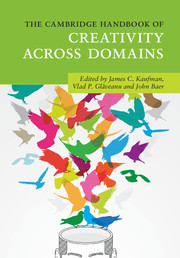Book contents
- The Cambridge Handbook of Creativity Across Domains
- The Cambridge Handbook of Creativity Across Domains
- Copyright page
- Dedication
- Contents
- Figures
- Tables
- Contributors
- Acknowledgments
- Part I Creativity and Domain
- Part II Creativity in the Traditional Arts
- Part III Creativity in the Sciences
- Part IV Creativity in Business
- Part V Newer Domains for Creativity Research
- Part VI Creativity in Everyday Life
- 29 Creativity in the Domain of Emotions
- 30 Creativity in Teaching
- 31 Culture and Creativity
- 32 The Benefits of Creativity in Therapy
- 33 Creativity in the Domain of Play
- 34 Creativity in Craft
- Part VII Conclusion
- Index
- References
32 - The Benefits of Creativity in Therapy
Current Evidence and Future Directions
from Part VI - Creativity in Everyday Life
Published online by Cambridge University Press: 15 September 2017
- The Cambridge Handbook of Creativity Across Domains
- The Cambridge Handbook of Creativity Across Domains
- Copyright page
- Dedication
- Contents
- Figures
- Tables
- Contributors
- Acknowledgments
- Part I Creativity and Domain
- Part II Creativity in the Traditional Arts
- Part III Creativity in the Sciences
- Part IV Creativity in Business
- Part V Newer Domains for Creativity Research
- Part VI Creativity in Everyday Life
- 29 Creativity in the Domain of Emotions
- 30 Creativity in Teaching
- 31 Culture and Creativity
- 32 The Benefits of Creativity in Therapy
- 33 Creativity in the Domain of Play
- 34 Creativity in Craft
- Part VII Conclusion
- Index
- References
Summary
Eminent creators have often anecdotally suggested that their creative work contributes positively to their well-being. In this chapter, we provide a brief review of the literature investigating the therapeutic benefits of creative activities. Specifically, we review what creative activities have been shown to be beneficial. To do so, we describe findings related to the study of art therapy, which has produced a rich body of empirical evidence. We also discuss research methods used to investigate the benefits of creative activities. Next, we review existing research examining how creative activities benefit those who engage in them, focusing on potential underlying processes – such as changes in affect or growth through adversity. Finally, we describe gaps in existing knowledge and recommend directions for future scholarship.
- Type
- Chapter
- Information
- The Cambridge Handbook of Creativity across Domains , pp. 587 - 601Publisher: Cambridge University PressPrint publication year: 2017



